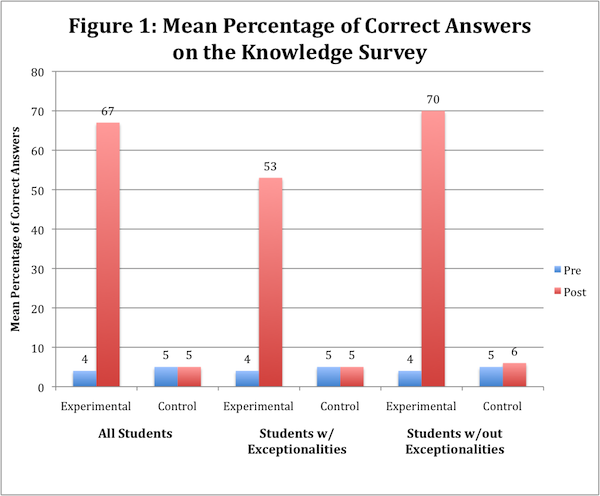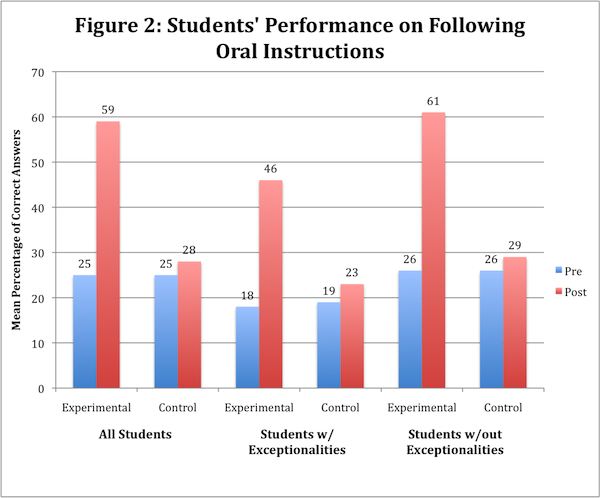Additional information
| Dimensions | 8.5 × 11 in |
|---|---|
| Cover | Paperback |
| Dimensions (W) | 8 1/2" |
| Dimensions (H) | 11" |
| Page Count | 42 |
| Publisher | Edge Enterprises, Inc. |
| Year Printed | 2001 |
$15.00
| Dimensions | 8.5 × 11 in |
|---|---|
| Cover | Paperback |
| Dimensions (W) | 8 1/2" |
| Dimensions (H) | 11" |
| Page Count | 42 |
| Publisher | Edge Enterprises, Inc. |
| Year Printed | 2001 |
Overview
The Following Instructions Together Program is used to teach students how to follow simple and complex instructions and to teach them how to help partners follow instructions. The research was conducted in 17 third- and fourth-grade general education classes. These intact classes were randomly assigned to the experimental or comparison condition. A total of 350 students participated in the pretest-posttest comparison-group design. The nine teachers of the experimental classes taught their students using the Following Instructions Together Program. The eight comparison teachers did not use this program.
Results
Observational data were gathered on the fidelity of the experimental teachers’ implementation of the instruction. They presented a mean of 89% of the information in the Following Instructions Together instructor’s manual.
All students in experimental and comparison classes completed a written test of their knowledge about following instructions and community-building skills at pretest and posttest. The ANCOVAs revealed significant differences between the posttest scores of experimental and comparison students with exceptionalities, F (1, 49) = 94.732, p < .001, η2 = .659, and students without exceptionalities, F (1, 12) = 663.131, p < .001, η2 = .978. (These are very large effect sizes.) For students with and without exceptionalities, the adjusted means for the experimental group were significantly larger than the adjusted means for the comparison group. (See Figure 1 for the mean scores.)

Data were also gathered on the students’ performance as they completed a worksheet that involved following instructions. The ANCOVAs revealed significant differences between the posttest worksheet scores of experimental and comparison students with exceptionalities, F (1, 49) = 13.629, p < .001, η2 = .218, and students without exceptionalities, F (1, 15) = 41.841, p < .001, η2 = .736. (These are very large effect sizes.) For students with and without exceptionalities, the adjusted means for the experimental group were significantly larger than the adjusted means for the comparison group. (See Figure 2 for the mean scores.)

Experimental teachers and students used a 7-point Likert-type scale to rate items regarding their satisfaction with the program (“7” indicating “extremely satisfied”; “1” indicating “extremely dissatisfied”) at the end of the year. Teachers endorsed the program, and their ratings indicated satisfaction with each aspect of the program. For example, teachers’ average satisfaction rating for “relevance of the program to your students” was 6.9, “students benefited from the instruction” was 6.7, “instruction was easy to use and incorporate” was 6.9, and overall satisfaction with the program was 6.9. Students also indicated that they were satisfied with the program, with mean scores on items ranging from 5.6 to 6.3. Ninety percent of the students recommended that all third-, fourth-, or fifth-grade students receive this instruction.
Reference
Vernon, D.S. (2000). Effects of the Following Instructions Together program: Progress summary for SBIR Phase II Grant #1R44HD34306. Washington, D.C.: National Institute of Child Health and Human Development.

D. Sue Vernon, Ph.D.
Affliations
My Background and Interests
By wearing my different hats (a university instructor, a certified teaching-parent, a trainer and evaluator of child-care workers, a SIM professional development specialist, a parent of three children (one with exceptionalities), and a researcher), I have gained knowledge and experience from a number of perspectives. I have a history of working with at-risk youth with and without exceptionalities (e.g., students with learning disabilities, emotional disturbance, behavioral disorders) in community-based residential group-home treatment programs and in schools. I also have extensive experience with training, evaluating, and monitoring staff who work with these populations, and I have conducted research with and adapted curricula for high-poverty populations. In addition to the Following Instructions Together program and other programs in the Community-Building Series, I’ve developed and field-tested the Cooperative Thinking Strategies Series, interactive multimedia social skills curricula, communication skills instruction, and professional development programs. I have also developed and validated social skills measurement instruments. As a lecturer of graduate-level university courses in the Department of Special Education at the University of Kansas, I have taught courses designed to enable teachers to access and become proficient in validated research-based practices.
The Story Behind the Following Instructions Together Program
My focus for the last 30 years has been on helping at-risk youths, particularly in the area of learning and using social skills. My interest in social skills instruction began when I was a teaching-parent in a group home for adolescents who had a history of social problems. One of our major goals in our group home was to make it a safe, respectful place where the youths would feel connected and comfortable while they were learning skills to help them succeed socially and academically. As I watched their growing success, I wanted to find a way to introduce social skills instruction to more children as a way to prevent social problems. I thought the perfect place for this instruction would be in the general education classroom.
Later, as reported school-related tragedies seemed to increase in frequency and become more deadly, I became especially interested in developing ways to prevent bullying and also in ways to create a kinder, more positive classroom environment than was commonly found in public education. A common thread in many interviews with the perpetrators of school violence was not only that they suffered from being bullied most of their lives, but they also felt no connection to their school and the people (e.g., administrators, teachers, or other students) in it.
As a result, two lines of research were born. My first series of research studies focused on social interactions in cooperative groups and resulted in the Cooperative Thinking Strategies Series. The importance of creating a positive, productive learning community in the classroom was part of each program in this series, but teachers indicated that they would like more information about creating learning communities. They wanted their students to be tolerant and supportive, and they wanted a way to systematically teach those concepts and skills to the whole class. As educators, my colleagues and I wanted to help teachers build learning communities where all student learning is supported, especially the learning of students who struggle in school. Thus, we began work on a series of instructional programs focused on the classroom community. Those programs now comprise the Community-Building Series. A founding premise associated with all the programs is that students are taught to work together and help each other.
We developed and tested the Following Instructions Together program in third-, fourth-, and fifth-grade inclusive general education classrooms. We tested the program in those grades to ensure that young students could benefit from the instruction; however, the program has since been used successfully in secondary classrooms as well. Our goal was to develop a program that benefited students both with and without exceptionalities by helping them become engaged and connected learners within a positive, supportive environment.
In the first lesson of the Following Instructions Together instruction, students review what they have learned in the Talking Together program (the first program in the Community-Building Series), including the prerequisite concepts of participating, working with partners, respect, tolerance and creating a learning community. The next lessons in the Following Instructions Together program involve teaching students confidence and competence-building skills and concepts associated with following instructions. Students first learn how to verify simple oral instructions with the help of a partner. Then they learn how to follow more complex sets of written and oral directions, and, finally, they learn a strategy for checking their written assignments before turning them in to ensure that they have followed all instructions accurately. Throughout, students learn to help their partners follow instuctions and check their work. They are then expected to use these skills and strategies in all class activities when appropriate. Student use of the strategies associated with this program is combined with a conscious effort on the part of the teacher to make sure instructions are clear and that everyone’s questions are answered. Thus, the teacher and students work together in partnership to create and maintain a productive learning community.
My Thoughts About Community-Building Instruction
The programs within the Community–Building Series were developed in response to comments from teachers. They asked for specific ways to systematically begin building a caring community of learners. The programs within this series help teachers and students explicitly think about different ways to create a truly supportive learning environment during routine daily activities (e.g., when having class discussions, when following instructions, when taking notes, when getting organized). The Following Instructions Together program is short and easy to use, and the instruction has been shown to be beneficial especially for those students who struggle with listening, paying attention, and knowing how to do what is required. Encouraging all students to treat one another in civil and kind ways was a program goal. Seeing students begin to make changes in their behavior after just a few lessons while they also significantly improve their accuracy in following instructions is exciting.
Teacher and Student Feedback on the Following Instructions Together Program
Many teachers at different grade levels have successfully used the program. Example comments include, “The Following Instruction lessons are terrific. The RULES Strategy gives kids who don’t know how to begin an assignment a step-by-step method. The WAIT Strategy is great, at the end of lessons, especially for the impulsive, speedy kids who ‘fly’ through assignments,” “Good life-long skills,” “I liked the application to improving school work, fewer trips to the teacher to have instructions repeated, and giving them something they can use to help themselves when they don’t understand what they are to do,” “This program is great. I will use it all of the time now,” “This really helped students in handing in their completed papers,” “Very easy to use,” ”I want to continue to use this program with the future classes that I will have. I would like to start the school year with these procedures,” and “Very teacher friendly!”
Examples of student comments include, “It (the program) is very helpful if you don’t know what to do. I think everybody has it down,” “I like being able to take time to help my neighbor,” “The RULES Strategy helps me remember what I need to do,” “The WAIT Strategy helps me remember to put my name and add the date,” “I like to do it (the WAIT Strategy) because I may forget something,” “This program really helps children want to participate,” “I learned people or even enemies are helpful,” “I liked it because I learned how to be safe,” “The best thing was that after the program we had no put downs,” “I liked the strategies and the working with a partner,” “I liked that we could get more responsible, work with a partner, and set goals,” and “The thing I liked most was that I felt extremely safe and comfortable.”
My Contact Information
Please contact me at svernon2@windstream.net

 Framing Routine
Framing Routine